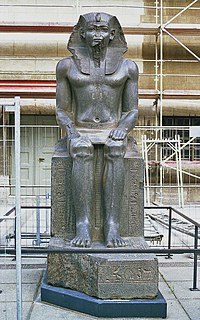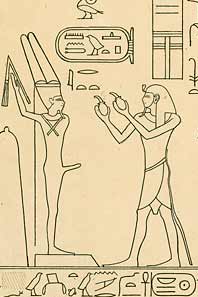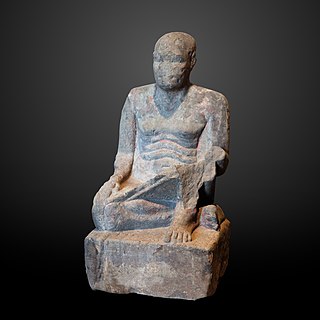Related Research Articles

Amenemhat III, also spelled Amenemhet III, was a pharaoh of the Twelfth Dynasty of Egypt. He ruled from c. 1860 BC to c. 1814 BC, the highest known date being found in a papyrus dated to Regnal Year 46, I Akhet 22 of his rule. His reign is regarded as the golden age of the Middle Kingdom. He may have had a long coregency with his father, Senusret III.

The Middle Kingdom of Egypt is the period in the history of ancient Egypt following a period of political division known as the First Intermediate Period. The Middle Kingdom lasted from approximately 2050 to 1710 BC, stretching from the reunification of Egypt under the reign of Mentuhotep II in the Eleventh Dynasty to the end of the Twelfth Dynasty. The kings of the Eleventh Dynasty ruled from Thebes and the kings of the Twelfth Dynasty ruled from el-Lisht.

The Egyptian pyramids are ancient pyramid-shaped masonry structures located in Egypt. As of November 2008, sources cite either 118 or 138 as the number of identified Egyptian pyramids. Most were built as tombs for the country's pharaohs and their consorts during the Old and Middle Kingdom periods.

The Twelfth Dynasty of ancient Egypt is often combined with the Eleventh, Thirteenth and Fourteenth Dynasties under the group title Middle Kingdom.

Amenemhat IV was the seventh and penultimate pharaoh of the 12th Dynasty of Egypt during the late Middle Kingdom period, ruling for over nine years in the late 19th century BC or the early 18th century BC.

Amenemhat I also Amenemhet I and the hellenized form Ammenemes, was the first ruler of the Twelfth Dynasty, the dynasty considered to be the golden-age of the Middle Kingdom of Egypt. He ruled from 1991 BC to 1962 BC.

Nubkaure Amenemhat II was the third pharaoh of the 12th Dynasty of Ancient Egypt. Although he ruled for at least 35 years, his reign is rather obscure, as well as his family relationships.

Senusret I also anglicized as Sesostris I and Senwosret I, was the second pharaoh of the Twelfth Dynasty of Egypt. He ruled from 1971 BC to 1926 BC, and was one of the most powerful kings of this Dynasty. He was the son of Amenemhat I. Senusret I was known by his prenomen, Kheperkare, which means "the Ka of Re is created."

Nebtawyre Mentuhotep IV was the last king of the 11th Dynasty. He seems to fit into a 7-year period in the Turin Canon for which there is no recorded king.

Lisht or el-Lisht is an Egyptian village located south of Cairo. It is the site of Middle Kingdom royal and elite burials, including two pyramids built by Amenemhat I and Senusret I. The two main pyramids were surrounded by smaller pyramids of members of the royal family, and many mastaba tombs of high officials and their family members. They were constructed throughout the Twelfth and Thirteenth Dynasties. The site is also known for the tomb of Senebtisi, found undisturbed and from which a set of jewelry has been recovered. The pyramid complex of Senusret I is the best preserved from this period. The coffins in the tomb of Sesenebnef present the earliest versions of the Book of the Dead.

Hor Awibre was an Egyptian pharaoh of the 13th Dynasty reigning from c. 1777 BC until 1775 BC or for a few months, c. 1760 BC or c. 1732 BC, during the Second Intermediate Period. Hor is known primarily thanks to his nearly intact tomb discovered in 1894 and the rare life-size wooden statue of the king's Ka it housed.

The Pyramid of Unas is a smooth-sided pyramid built in the 24th century BC for the Egyptian pharaoh Unas, the ninth and final king of the Fifth Dynasty. It is the smallest Old Kingdom pyramid, but significant due to the discovery of Pyramid Texts, spells for the king's afterlife incised into the walls of its subterranean chambers. Inscribed for the first time in Unas's pyramid, the tradition of funerary texts carried on in the pyramids of subsequent rulers, through to the end of the Old Kingdom, and into the Middle Kingdom through the Coffin Texts that form the basis of the Book of the Dead.

The Pyramid of Amenemhet I is an Egyptian burial structure built at Lisht by the founder of the Twelfth Dynasty of Egypt, Amenemhet I.

The Ancient Egyptian official Meketre was chancellor and high steward during the reign of Mentuhotep II, Mentuhotep III and perhaps Amenemhat I, during the Middle Kingdom.

Mentuhotep was an Ancient Egyptian official and treasurer under the 12th dynasty pharaoh Senusret I. Mentuhotep is one of the best attested officials of the Middle Kingdom period. There is a series of statues found at Karnak, showing him as a scribe. On these he has been given the title of overseer of all royal works, which would suggest that he was involved in overseeing the construction of the temple at Karnak. At el-Lisht he had a large tomb next to the pyramid of Senusret I. When it was found it was badly damaged, but there are remains of high quality reliefs and fragments of statues. The burial chamber still contained two sarcophagi, one smashed and the other one well preserved, made of granite and with brightly painted interiors.
Senusret was an Ancient Egyptian official who was a vizier during the last years of king Senusret I's rule and in the first years of Amenemhet II. Senusret is known from a stela found in Abydos, which is dated to year 8 of Amenemhet II. He also appears in biographical inscriptions in the tomb of the governor Amenemhat at Beni Hasan, where it is reported that he was on a mission to Koptos. The inscription reports events under Senusret I.

Rehuerdjersen was an Ancient Egyptian treasurer who held this office under the 12th Dynasty pharaoh Amenemhat I.

Senebtisi was an Ancient Egyptian woman who lived at the end of the 12th Dynasty, around 1800 BC. She is only known from her undisturbed burial found at Lisht.
Nakht was an Ancient Egyptian official living around 1950 BC under king Senusret I in the Twelfth Dynasty. His main title was high steward. As high steward he was responsible for the domains providing the palace and the royal residence with food and other resources.
Ameny was an Ancient Egyptian official of the Twelfth Dynasty, most likely in office under king Amenemhat II. Ameny was great overseer of the troops and is mainly known from a series of stelae (Paris, Louvre C 35, Cairo CG 20546, London, British Museum 162 once set up at Abydos and there adorning a chapel. On these stelae he bears the most important ranking titles member of the elite, foremost of action, royal sealer and sole friend. As great overseer of the troops he was the leading official at the royal responsible organizing manpower that was used in military enterprises, but also for building projects. Ameny was the son of a person called Qebu. On each stelae a different wife is mentioned. These are Itet, Renefankh and Medhu. His tomb was found at Lisht, but is not yet fully excavated. The stelae of Ameny are not dated by any king's name. However, on stylistical grounds they most likely date under king Senusret I and Amenemhat II.. Some of the biographical phrases on the stelae indicate a date more precisely under the latter king.
References
- ↑ Dieter Arnold: Middle Kingdom Tomb Architecture at Lisht, New York 2008, ISBN 978-1-58839-194-0, pp. 85-86, pls. 162-164
- ↑ James P. Allen: The high officials of the early Middle Kingdom, in: Nigel Strudwick, John H. Taylor (editors): The Theban Necropolis, Past, Present and Future, London 2003, ISBN 0714122475, p. 17